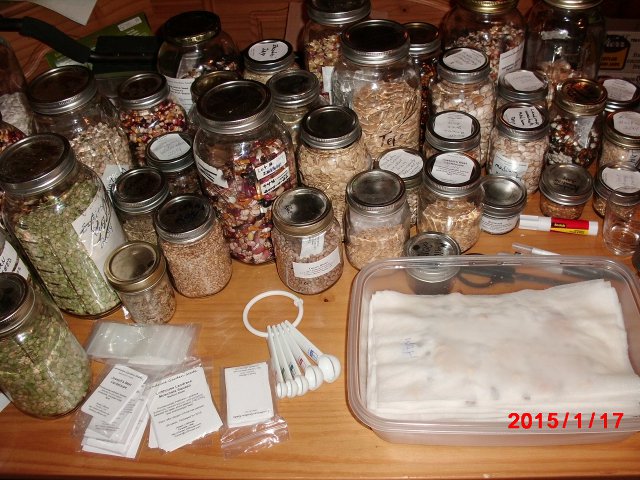Simple Seed Saving — The Landrace Gardening Way
Modern Seed Saving With Ancient Roots
The Landrace Gardening Course will probably turn your gardening world upside down but in a good way.
You'll learn to grow plants that can stand up to pests and diseases, and to the challenges of climate change.
The heart of Landrace Gardening is the ancient practice of seed saving and plant breeding.
 Photo Credit - Joseph Lofthouse —
Seeds from 2014
Photo Credit - Joseph Lofthouse —
Seeds from 2014Instead of isolating individual varieties Landrace seed saving encourages crosses between varieties, the more crosses the better. It turns you into a plant breeder but one who lets the environment train your plants. And Nature can be brutal.
Guess what? If half your first generation of crosses fail that's actually a good thing. Chances are you're well on your way to landrace seed line that works in your garden.
I am so impressed with this course I have become an enthusiastic affiliate, meaning if you click a link and decide to buy the course i will earn a commission at no extra cost to you.
What's in the Landrace Course Bundle?
rThe Landrace Gardening Course
The people who created this course are Joseph Lofthouse and Julia Dakin. Joseph's path to landrace gardening started with a search for colorful sweet corn. He is the main instructor for this course.
Julia's start was a surprising study on nutrient density. After accessing and delving into the raw data the only correlation seems to have genetics at it's base, in other words seeds and their genetics really matter.
The main instructor for this course is Joseph Lofthouse, a Utah market farmer and the author of the book Landrace Gardening. You find a short story in the next section about some colorful corn leading him to radically change his growing methods.
There are 44 lessons in this course.
- Overview — 5 lessons covering basic material on the foundation of Landrace Gardening
- Growing Your Own Landrace — 10 lessons with steps to take to start your own landrace
- Selection Processes for Specific Crops — 8 lessons
- Selection in the Second Year and Beyond —4 lessons
- Applied Landraces Other Contributors — 7 stories
- Seed Saving — 5 Lessons
- Optional — 5 lessons
The paid version also includes these awesome extras:
- How Microbes Help Local Adaptation — A 27 lesson course taught by Dr James White. This is a valuable mind bending course. For example did you know all plants have the ability to host nitrogen fixing endophytes in their leaves and or roots?
- Indigenous Farmers of the Americas — This course is in development and will be available at the end of 2022.
- Membership in the Landrace Gardening Community — A chance to meet and talk to others on the same journey. The journey can be tough and it would be nice to be reassured as your environment sets about training your plants to be strong. Yikes! And Don't Panic!
- Access to the Landrace Seed Trading Group — Landrace plant breeding is best with community. Sharing our authentically genetically diverse seeds can give us all a leg up.
- Monthly Zoom calls with Joseph Lofthouse
What's in the Free Course?
The free course will give you a solid taste of the main landrace gardening course.
It includes 13 lessons from the main course.
- An Introduction — 1 lesson
- Whats and Whys — 5 foundation lessons
- The First Year — 5 lessons
- Winter Squash — 2 lessons
This is enough to get you going. If you find it's what you're looking for you can go ahead and buy the full access course.
Joseph and His Corn of Many Colors
Meet Joseph Joseph Lofthouse, the main course instructor and a market gardener growing crops in a challenging environment. His farm is in a high mountain valley near Paradise Utah. The challenges:
- short 85-110 day growing season
- those pretty snow covered peaks send a chilly breezes
- extreme daily temperature shifts - hot sunny days and cold nights
- low humidity and low rainfall
Before he adopted landrace methods Joseph bought and tried many different seeds, both heirlooms and modern hybrids. It was not unusual for a 75% to 95% crop failure with these seeds.
He had been growing a hybrid sweet corn with some success for many years but he wanted to offer his customers a more colourful sweet corn.
Instead of trying a new single variety he picked up a sweet corn landrace developed by Illinois seedman Alan Bishop. Alan collected some 200 varieties of sweet corn and just threw them all together. The result, a landrace sweet corn he christened Astronomy Domine was born.
Joseph planted Alan’s landrace sweet corn in his mountain valley. In the challenging very non-Illinois conditions in Utah some of the plants died. That’s okay. The genetics of those weren’t suited to their new environment.

Others thrived outwitting both the climate and the skunks and pheasants.
The thrivers were a lovely colourful sweet corn suited to his garden.
Joseph saved the seeds from those successes replanting them year to
year. The result - a Lofthouse Astronomy Domine that ripens about 10
days earlier than the original.
That sweet corn success inspired a
complete shift in Joseph’s market garden. Instead of fighting the
environmental challenges he embraces them and has developed a slew of
other landrace seed strains including musk melons, watermelon.
cucumbers, and fava beans.
In 2021 Joseph published a book sharing his knowledge and experience with Landrace Gardening. Landrace Gardening is available through Amazon and can be treated as a textbook reference to supplement the course.